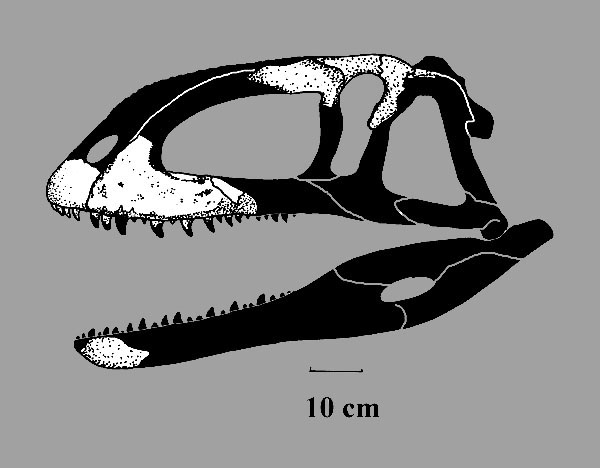
Genus: Indosuchus HUENE, 1932
Etymology: Latin Indus “India”, and Greek, suchos, "crocodile"; Indian
crocodile.
= Indosuchas MALKANI, 2006 (sic)
Species: raptorius HUENE, 1932
Etymology: Latin, raptor, "robber."
Lectotype: GSI K27/685
Locality: Carnosaur bed, west slope of Bara Simla Hill, Jubbulpure, Madhya Pradesh State, India.
Horizon: Lameta Formation.
Biostratigraphy:
Age: Middle-Late Maastrichtian Stage, Upper Senonian Subepoch, Upper Gulf Epoch, Late Cretaceous.

Material: Posterior part of skull roof.
After CHATTERJEE, 1996, AMNH 1753, 1955, 1960, ISI R 163
Referred material:
CHATTERJEE & RUDRA, 1996
Locality: Raiholi Site, Gujarat State, India.
Horizon: Lameta Formation.
Biostratigraphy:
Age: Middle-Late Maastrichtian Stage, Upper Senonian Subepoch, Upper Gulf Epoch, Late Cretaceous.
Material:
Number: Not given: Fragmentary skull and skeleton.
Note: May or may not belong to this genus.
K20/350: Consists of the broad and firmly coalesced frontals.
K27/690: Right frontal.
GSI K27/580: Postorbital.
GSI K27/708: Lachrymal.
CHATTERJEE, 1978
AMNH 1753: A pair of premaxillae.
AMNH 1955: Left maxilla.
AMNH 1960: Right dentary fragment.
CHATTERJEE & RUDRA, 1996
ISI R 163: Lachrymal, jugal and posterior part of the jaw.
Locality: Raiholi Site, Gujarat State, India.Horizon: Lameta Formation.
Biostratigraphy:
Age: Middle-Late Maastrichtian Stage, Upper Senonian Subepoch, Upper Gulf Epoch, Late Cretaceous.
Material:
ISI R401-454: Skull and a nearly complete skeleton.